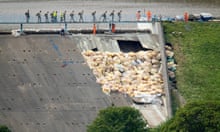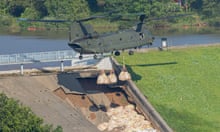The Whaley Bridge dam scare is a warning of the potentially disastrous consequences of failing to build new infrastructure to cope with the climate emergency, experts have said.
As the environment secretary, Theresa Villiers, chaired a meeting of the Cobra emergency committee on efforts to make the dam safe, the government was facing calls for an urgent overhaul of flood defences and water infrastructure.
Villiers said the government was ensuring that “everything possible is being done to draw down water levels, fix damage to the dam and protect homes and businesses.”
Bob Ward, a policy director at the Grantham Research Institute on Climate Change and the Environment, said: “This is an example where our infrastructure is not up to scratch and we are not acting quickly enough to upgrade it. It is a warning to Villiers that she has got to put climate resilience at the top of the government’s list.
“It is all very well worrying about Brexit, but without upgrading infrastructure we are going to suffer more and more grave consequences. If you delay on this, all you are doing is setting us up for disaster.”
Ward said the government had been “caught on the hop” by the two wettest winters on record, in 2013 and 2015. In response it promised a flood resilience review, but so far it has examined only river flooding and not the impact of surface water flooding.
In May the Environment Agency said an increase in extreme flooding events could force thousands of people to move away from coastal regions.
Ward said: “We have the flood defence system fit for the climate of the 20th century when we need it fit for the 21st century. We are going to see more record rainfall, more flooding along our coasts and rivers, and we are just not prepared for that.”
Paul Sheffield, a senior vice-president at the Institution of Civil Engineers, said incident at the Whaley Bridge dam, which was built in the 1830s, was a “timely reminder that we cannot afford to underinvest in infrastructure”.
He said: “Every bit of infrastructure is going to be exposed to more onerous events than it was originally designed for, so it obviously has to be reviewed.”
Sheffield, who was a civil engineer on the Maentwrog dam in north Wales, one of the only new concrete dams built in the UK in the last 50 years, said flood defences should be built at least a metre higher.
“In Holland whenever they strengthen their sea defence structures they are taking the precaution of building them a metre higher than they were 50 years ago because of the possibility of flood events. This is something the UK government needs to look at. Our flood defences will need to be raised,” he said.
The government is due to respond soon to a review by the National Infrastructure Commission (NIC) that urged it to commit to spending 1.2% of GDP on infrastructure and ensure a further 1.8% of GDP is provided by the private sector.
Sheffield said much of this potential investment was now in jeopardy. “We just need to be really careful in this country that we don’t frighten overseas investors away from investing in infrastructure,” he said. “Political uncertainty, not only around Brexit but also the meltdown in UK politics, will inevitably make infrastructure investment organisations from overseas more nervous about investing in this country.”
The NIC also called for a series of six-year funding programmes until 2050 to ensure UK households were resilient to flooding.
The cost to the public purse would be about £1bn annually, but as yet no government minister has adopted the proposals or set about putting what is a long term flood resilience programme into action.
Phil Graham, the chief executive of the NIC, said: “Flood resilience is a major issue, it is important for the economy and for society and we are a world away from where we need to be. It requires a long-term, ambitious response because the impacts of climate change are going to make events like this more and more likely, not less and less likely.”
Terry Fuller, the chief executive of the Chartered Institution of Water and Environmental Management, said: “There is no doubt the UK is nowhere near resilient enough or ready for even the current climate let alone anything we are going to see in the coming decades. The message is getting through [to the government] but whether something is done about it remains to be seen and there is very little doubt that we will see more events like this.”








